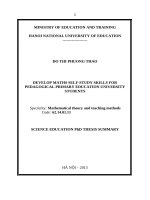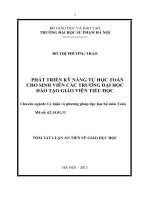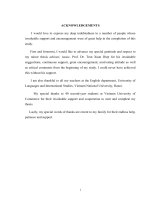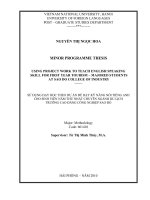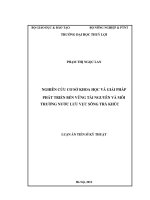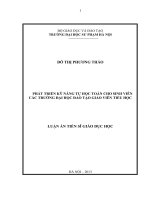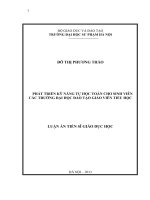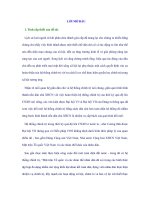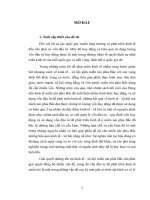(Luận án tiến sĩ) Tích hợp các hoạt động đa trí tuệ để phát triển kỹ năng nói tiếng Anh cho sinh viên chuyên ngữ
Bạn đang xem bản rút gọn của tài liệu. Xem và tải ngay bản đầy đủ của tài liệu tại đây (3.33 MB, 240 trang )
MINISTRY OF EDUCATION AND TRAINING
HUE UNIVERSITY
UNIVERSITY OF FOREIGN LANGUAGES
CHÂU VĂN ĐÔN
INTEGRATING MULTIPLE INTELLIGENCES-BASED
ACTIVITIES INTO TEACHING SPEAKING SKILLS
TO EFL LEARNERS
DOCTOR OF PHILOSOPHY THESIS IN THEORY AND
METHODOLOGY OF ENGLISH LANGUAGE TEACHING
HUE, 2019
MINISTRY OF EDUCATION AND TRAINING
HUE UNIVERSITY
UNIVERSITY OF FOREIGN LANGUAGES
CHÂU VĂN ĐÔN
INTEGRATING MULTIPLE INTELLIGENCES-BASED
ACTIVITIES INTO TEACHING SPEAKING SKILLS
TO EFL LEARNERS
DOCTOR OF PHILOSOPHY THESIS IN THEORY AND
METHODOLOGY OF ENGLISH LANGUAGE TEACHING
Code: 9 14 01 11
Supervisor:
Assoc. Prof. TRƯƠNG VIÊN, PhD
HUE, 2019
BỘ GIÁO DỤC VÀ ĐÀO TẠO
ĐẠI HỌC HUẾ
TRƯỜNG ĐẠI HỌC NGOẠI NGỮ
CHÂU VĂN ĐÔN
INTEGRATING MULTIPLE INTELLIGENCES-BASED
ACTIVITIES INTO TEACHING SPEAKING SKILLS
TO EFL LEARNERS
LUẬN ÁN TIẾN SĨ CHUYÊN NGÀNH LÝ LUẬN
VÀ PHƯƠNG PHÁP DẠY HỌC BỘ MÔN TIẾNG ANH
MÃ NGÀNH: 9 14 01 11
NGƯỜI HƯỚNG DẪN:
PGS.TS. TRƯƠNG VIÊN
HUẾ, 2019
STATEMENT OF AUTHORSHIP
The thesis entitled “Integrating Multiple Intelligences-based Activities into
Teaching Speaking Skills to EFL Learners” has been submitted for the degree of
Doctor of Philosophy.
I, the undersigned, hereby declare that I am the sole author of this thesis. I
have fully acknowledged and referenced the ideas and works of others, whether
published or unpublished, in my thesis.
My thesis does not contain work extracted from a thesis, dissertation or
research paper previously presented for another degree or diploma at this or any
other educational institute.
Signature
CHÂU VĂN ĐÔN
i
ABSTRACT
With the philosophy “Every learner is unique and intelligent”, the Theory of
Multiple Intelligences (MIT) has proved to be a humanitarian and favorable premise
to foster and promote learners’ language skills. Armstrong (2017) remarked while
traditional language teaching and learning programs mainly focus on developing
learners’ linguistic and reasoning skills, MIT proposes there are many other ways in
which learners’ language skills can be developed better. As the major aim of
Communicative Language Teaching (CLT) is to enable students to promote their
speaking skills to achieve progress in communicative competence, EFL instructors
should create favorable conditions for students to develop their speaking skills.
This study was an attempt to investigate the possible effects of integrating
MI-based activities into developing the EFL students’ speaking skills, and then to
find out the students’ evaluation of such an integration of MI-based activities.
Therefore, to attain those two main objectives, the mixed research method was
adopted: the quantitative approach utilizing a quasi-experimental study in which
MI-based activities were integrated into an experiment. The participants were 60
EFL second-year students from the research site, randomly selected on their
voluntary basis and were divided into an experimental group and a control group.
The possible effects of such an integration of MI-based activities into the speakingtraining program were measured via the means of a pre- and post-test and the
questionnaire administered to the experimental group as the two main research
instruments. The qualitative approach, aiming at collecting some supplementary
evidence regarding the participants’ responses. Qualitative data were collected from
30 experimental participants via the evaluation form and the interviews with six
randomly chosen participants from the experimental group.
The findings from the English speaking pre-test and post-test revealed
significant statistical differences between the participants’ test scores of their EFL
oral performances before and after taking part in the instructional intervention. The
ii
results of data analysis of the test scores shows that there was a significant
difference (M = .43) in favor of the post-test. Such an improvement of the mean
score in the post-test indicates that the program had some effects on improving the
students’ speaking skills as well as enhancing their learning motivation.
From the findings of the study, it is also depicted that the participants had
positive evaluation of the integration of MI-based activities. Their support and
satisfaction of the MI-based activities were indicated at high levels in terms of their
better perceptions of their specific MI profiles, their acknowledgement of the
benefits of the MI-based activities in facilitating their speaking skills, building up
their confidence, promoting their learning motivation, and increasing their
engagement in the discussion and interaction activities.
Based on the above-mentioned findings, some implications are proposed
from this research regarding the effectiveness of integrating MI-based activities on
developing EFL students’ speaking skills, and the feasibility of promoting EFL
students’ oral performances by integrating MI-based activities into EFL speaking
training programs.
iii
ACKNOWLEDGEMENTS
With all of my gratitude, I would like to express my whole-hearted thanks to
the ones who contributed to this thesis with their academic expertise, substantive
help or emotional support.
First and foremost, I would like to express my deepest gratitude to my
supervisor, Assoc. Prof. Dr. Trương Viên for his continuous guidance, help, support
and encouragement throughout the course of this study.
Secondly, my sincere thanks also go to the lecturers of the University of
Foreign Languages, Hue University: Assoc. Prof. Dr. Trần Văn Phước; Assoc. Prof.
Dr. Phạm Thị Hồng Nhung; Assoc. Prof. Dr. Lê Phạm Hoài Hương; Dr. Trương
Bạch Lê; Dr. Phạm Hồng Anh, who have whole-heartedly guided me through each
phase of this journey. I always feel your care about my study and professional
development. Therefore, once again, I would like to express my deep thanks for all
your kind help and enthusiastic encouragement.
I also own a word of thanks to Assoc. Prof. Dr. Lưu Quý Khương and Assoc.
Prof. Dr. Tôn Nữ Mỹ Nhật for giving me such valuable suggestions for improving
the quality of my thesis. I would also like to express my thanks to the Board of
Rectors of my university for creating all the favorable conditions for me to take part
in this Ph.D. program. I am grateful to the lecturers and students of the Foreign
Languages Department of the university where the experiment for this study is
conducted, particularly the students of second-year EFL class 2014-2019 (DC14)
for their participation into the experimental study by filling the questionnaires,
taking the pre/post-test, and answering the interview.
Last but not least, the unconditional, innumerable, great affection, sacrifice
and care of my family members for me during my Ph.D. program-taking journey
beyond words. They are always the source of motivation and aspiration for me to
overcome all my difficulties and achieve what I have academically dreamed so far.
iv
LIST OF ABBREVIATIONS
CEFR
European Framework of Reference for Languages
CLT
Communicative Language Teaching
EFL
English as a Foreign Language
ESL
English as a Second Language
IC
Intelligence Center
IQ
Intelligence Quotient
IT
Information Technology
LC
Learner-centered
LLS
Language Learning Strategy
MI
Multiple Intelligences
MIDAS
Multiple Intelligences Developmental Assessment Scales
MIT
Multiple Intelligences Theory
MOET
Ministry of Education and Training
PBL
Project-based Learning
EF
Evaluation Form
SLA
Second Language Acquisition
SPSS
Statistical Package for the Social Sciences
TEFL
Teaching English as a Foreign Language
TPR
Total Physical Response
ZPD
Zone of Proximal Development
v
LIST OF TABLES AND FIGURES
Table 3.1
Instruments used in the research .....................................................
41
Table 3.2
Summary of the procedures of the main study ...............................
60
Table 3.3
Stages of analyzing interview data .................................................
64
Table 4.1
Descriptive statistics of mean performance in pre and post-test ....
71
Table 4.2
Residuals Statisticsa ………………………………………….….
71
Table 4.3
Case Processing Summary ……………………………………...
72
Table 4.4
Test of Homogeneity of Variances ……………………………...
72
Table 4.5
Difference between means of pre-test and post-test …………….
72
Table 4.6
Mean score of pre-test in comparison with the accepted mean .....
73
Table 4.7
Mean score of the post-test in comparison with the good mean ....
73
Table 4.8
Participants’ English-speaking performances within 2 groups
before and after the experimental program ....................................
74
Table 4.9
Correlation between the results of the pre-test and the post-test ....
76
Table 4.10
Means scores of experimental participants’ pre and postquestionnaire ...................................................................................
85
Table 4.11
Grouped data for the 6 clusters in the pre-questionnaire ...............
86
Table 4.12
The mean scores of the pre-questionnaire ......................................
87
Table 4.13
Comparing mean score of Pre-questionnaire and Scale 3 (NS)......
88
Table 4.14
Grouped data for 6 clusters in post-questionnaire .........................
89
Table 4.15
Mean scores of post-questionnaire..................................................
89
Table 4.16
Comparing mean score of Post-questionnaire and Scale 4 (“A”) .......
90
Table 4.17
Participants’ preferred MI-based activities ....................................
97
Table 4.18
Summary of the study findings ....................................................... 132
vi
Figure 3.3
The research procedures ................................................................
39
Figure 4.1
Participants’ intelligences profiles .................................................
69
Figure 4.2
Participants’ speaking performances reported in pre & post tests
(both groups) reported in speaking pre-test and post-test ...............
vii
75
TABLE OF CONTENTS
Page
STATEMENT OF AUTHORSHIP ....................................................................
i
ABSTRACT .......................................................................................................
ii
ACKNOWLEDGEMENTS ................................................................................
iv
LIST OF ABBREVIATIONS .............................................................................
v
LIST OF TABLES AND FIGURES ..................................................................
vi
TABLE OF CONTENTS ....................................................................................
viii
CHAPTER 1: INTRODUCTION ....................................................................
1
1.1. Background of the study ..............................................................................
1
1.2. Statement of the problem .............................................................................
3
1.3. Research objectives ......................................................................................
4
1.4. Research questions .......................................................................................
5
1.5. Research scope .............................................................................................
5
1.6. Significance of the study ..............................................................................
5
1.7. Organization of the thesis.............................................................................
7
CHAPTER 2: LITERATURE REVIEW ........................................................
9
2.1. Multiple Intelligences Theory ......................................................................
9
2.2. Individual differences in an English speaking class.....................................
13
2.3. Social Interaction, Learning Styles and Individual Differences ..................
14
2.3.1. Relationship between Multiple Intelligences, Learning Styles, LearnerCenteredness, and Communicative Approach ....................................................
17
2.3.1.1. Multiple Intelligences and Learning Styles ...........................................
17
2.3.1.2. Learner-centeredness approach ..............................................................
18
2.3.1.3. Communicative approach.......................................................................
19
2.4. Speaking skills .............................................................................................
20
2.4.1. Definition of speaking ...............................................................................
20
2.4.2. Components of speaking skills .................................................................
21
viii
2.4.3. Definition of MI-based speaking activities ...............................................
21
2.4.3.1. Project-based activities ……………………………………………….
24
2.4.3.2. Poster-making activities ………………………………………………
24
2.4.3.3. Common features between project-based and poster-making activities
25
2.5. Implementing MI-based activities in EFL classrooms ...............................
26
2.6. Previous studies relating to the application of MIT .....................................
27
2.6.1. Previous studies on integrating MI-based activities in teaching speaking
27
2.6.2. Some viewpoints on integrating MI-based activities into speaking
instruction ................................................................................................................
32
2.7. Chapter summary .........................................................................................
35
CHAPTER 3: RESEARCH METHODOLOGY ............................................
36
3.1. Revisiting the Research Questions ..............................................................
36
3.2. Research design ............................................................................................
36
3.3. Research procedures.....................................................................................
38
3.4. Research participants ...................................................................................
40
3.5. Research instruments ...................................................................................
41
3.5.1. MI inventory..............................................................................................
42
3.5.2. English-speaking pre-test and post-test.....................................................
43
3.5.3. Questionnaires ...........................................................................................
44
3.5.4. Evaluation form .........................................................................................
45
3.5.5. Interview ...................................................................................................
46
3.6. Research context ..........................................................................................
48
3.7. Roles of the researcher .................................................................................
49
3.8. Ethical issues ................................................................................................
49
3.9. Research implementation .............................................................................
50
3.9.1. The pilot study...........................................................................................
50
3.9.2. The official study ......................................................................................
52
3.9.2.1. Overview ................................................................................................
52
3.9.2.2. The Conventional speaking-training program .......................................
52
3.9.2.3. The experiment.......................................................................................
58
ix
3.9.3. Administering the MI inventory ...............................................................
61
3.9.4. Administering questionnaires ...................................................................
61
3.9.5. Administering speaking pre-test and post-test ..........................................
62
3.9.6. Administering interviews and evaluation form .........................................
62
3.10. Data analysis ..............................................................................................
63
3.11. Research reliability and validity ................................................................
65
3.12. Chapter summary .......................................................................................
66
CHAPTER 4: FINDINGS AND DISCUSSION .............................................
67
4.1. Effects of integrating MI-based activities ....................................................
67
4.1.1. Participants’ MI profiles ...........................................................................
68
4.1.2. Participants’ speaking performances before and after experiment ...........
69
4.1.2.1. Participants’ speaking performances between two groups ....................
70
4.1.2.2. Comparison of the participants’ speaking performances within the
control group prior to and after the experiment ..................................................
74
4.1.2.3. Comparison of the participants’ speaking performances within the
experimental group prior to and after the study ..................................................
74
4.1.2.4. Exploratory investigation: Correlation between the results of the pretest and the post-test ............................................................................................
76
4.2. Discussion of the effects of integrating MI-based activities ........................
77
4.3. Participants’ evaluation of the integration of MI-based activities ...............
83
4.3.1. Participants’ responses in the questionnaires ............................................
84
4.3.1.1. Findings from pre-questionnaire ............................................................
86
4.3.1.2. Findings from post-questionnaire ..........................................................
89
4.3.2. Participants’ responses in the evaluation form .........................................
99
4.3.3. Participants’ responses in the interviews ..................................................
104
4.3.4. Impacts of the extra-curricular speaking-training activities .....................
117
4.4. Discussion of findings on participants’ evaluation of integrating MIbased activities ...................................................................................................
121
4.4.1. Participants’ perceptions of integrating MI-based activities ……………
121
x
4.4.2. Benefits of integrating MI-based activities ……………………………..
124
4.4.3. Participants’ support of integrating MI-based activities ……………….
125
4.4.4. Participants’ preferred MI-based activities suitable with MI profiles …..
127
4.4.5. Frequency of using teaching materials ………………………………….
130
4.4.6. Some remaining problems with integrating MI-based activities ……….
131
4.5. Chapter summary .........................................................................................
133
CHAPTER 5: CONCLUSION AND IMPLICATIONS ...............................
134
5.1. Summary of the key findings .......................................................................
134
5.2. Pedagogical implications .............................................................................
137
5.3. Limitations of the study ...............................................................................
140
5.4. Recommendations for further study .............................................................
140
REFERENCES ....................................................................................................
142
AUTHOR’S WORKS
150
LIST OF APPENDICES .....................................................................................
151
xi
CHAPTER 1: INTRODUCTION
Introduction
This chapter presents the background of the study, the rationale, objectives,
and scale of the research. Then, the significance of the research is mentioned and
discussed.
1.1. Background of the study
The primary goal of learning a foreign language, according to Brown (2001),
is the competence to carry out communicative activities in which learners are able
to use the target language and express it properly in real-life situations for various
functions and different extents. In language study, oral communicative skills
(mainly speaking and listening competencies) are normally regarded as the ones of
most considerable difficulties to be trained and developed. Such difficulties in
developing speaking skills, according to Harmer (2007), are mainly due to the lack
of authentic documents and environment for practicing speaking the language as
well as the learners’ acquisition methods. Applying various and flexible methods
based on a learner-centered approach and promoting diverse and multiple skills and
intelligences can help develop learners’ oral communicative skills.
Creating a friendly and encouraging EFL speaking environment can help
language learners to communicate effectively with one another. Within this such a
motivating academic environment, language learners feel comfortable to express
and exchange their ideas orally, and thus, make their progress in speaking skills.
“Application of MI-based approach helps students to promote their positive
strengths as well as design relevant learning methods in an effective academic
environment” (El-Naggar, 2000, p. 25).
The traditional methods of language teaching and learning, argued by Nunan
(1991), Savignon (2000), Larsen-Freeman (2000), and Brown (2001), first of all,
are generally based on sentence patterns and models of teaching procedures for
practicing how to use the language applied and built from such fixed grammatical
points. Therefore, such a classroom use of the language might likely be entirely
1
isolated from its authentic socio-cultural contexts and functions. Also, the four
language skills are often trained and developed through separated classroom
activities generally implemented in a teacher-controlled atmosphere, and the
students have limited chances for participation. Most important of all, the speaking
skills, in such traditional teaching and learning methods, are trained and practiced
based on the teacher’s models of drills and much attention is paid to error
correction, not to highlight and promote the students’ communicative competences.
It can be seen that not much importance is attached to the individual distinction
among the different learners regarding their preferences or styles of acquiring and
producing the target language that they have learned. Thereof, it is indicated by
Johnson (2013) that in traditional classrooms, the students with highly developed
analytical and reasoning skills are the ones who are more likely to be considered
successful learners according to the instructors’ assessment.
Dorgham (2011) proposed that most learners own various types and levels of
intelligences and utilize them following their own ways. Therefore, teachers should
always be aware that learners have differential learning styles, levels of
intelligences in participating and performing classroom activities. Nunan and Baily
(2009), Oxford (2001), and Ezarik (2001) also shared their common viewpoint that
teachers could find their proper ways of teaching through focusing on the students’
learning styles and thinking strategies:
Teachers are in a bad need to find the right strategies to fit the diverse learning
styles of each individual within the classroom context. In order to achieve the
required skills, the eight MIs need incorporating into everyday classroom learning
(Ezarik, 2001, p. 143).
The change from teacher-centered to learner-centered approach to learning
means a reduction in teacher domination, with a corresponding increase in student
control and initiative (Jones, 2007; Geven & Attard, 2012; Johnson, 2013; Crumly,
2014; and Hoidn, 2016). Learner-centeredness has proved to be a practical approach
in EFL teaching and learning. Johnson (2013, p. 19) views “learner-centered
approach is self-directed learning.” The principle of learner-centeredness stipulates
2
that “the teacher's role is a facilitator, with the student acting as a reflective partner”
(Crumly, 2014, p. 26).
Therefore, learning styles and multiple intelligences can be considered
focusing on learner-centeredness and share some common characteristics: the
teacher’s role, in these language teaching and learning approaches, is the one of a
facilitator and a helper, and the learner working as a sharing and active partner.
Another common feature that these theories share among each other is the
viewpoint of training the learner as an entire person. Ahmed (2013) remarked,
“Shifting the central roles from the teacher-centeredness to the student-centeredness
in classroom activities conforms with Dewey’s concept of empowering the
students” (p. 115). According to Gardner (1983), intelligence is defined as “the
ability to deal with problems in real-life situations or to propose solutions
practically valuable in various cultural and social contexts” (p. 214). He proposed
that individuals possess at least eight types of intelligences: bodily-kinesthetic;
interpersonal;
musical-rhythmic;
verbal-linguistic;
visual-spatial;
logical-
mathematical; intrapersonal and naturalistic. Recently, two more types of
intelligences named spiritual and existential were added by Gardner (1996).
1.2. Statement of the problem
In general, there have been quite a lot of research to investigate the effects of
MIT application aiming at developing learners’ linguistic knowledge and
communicative competence (e.g., Campbell, 1994; Armstrong, 1993; Christison,
1996 & 1999; Younas & Subhani, 2015; among the others). However, in the field of
applying MI-based activities to promote language learners’ speaking skills, the
number of such studies is minimal (Orhan & Hasan, 2015).
Speaking in the target language has taken up a significant place throughout
the history of language teaching and learning (Brown, 2001 and Nunan, 1991).
Nowadays, speaking skills have themselves manifested to be a separate field of
teaching, learning, and assessment. Nevertheless, Nunan (1991) and Samira (2014)
commented that little attention has still been paid to spoken discourse production.
Due to the difficulties in learning how to speak in the target language, it is,
3
therefore, more facile for many teachers and students to concentrate on the written
form and use of the language instead of developing the speaking skills.
Vietnamese EFL students are in the same situation and always confront with
many difficulties in learning English as a foreign language, particularly how to
develop their EFL speaking skills. This reality is reflected in the results of their
language tests and examinations, from the high-school graduation exams in general
English to the communicative skills tests in particular at tertiary level.
From the survey of the test scores of the EFL first-year students at the
Foreign Languages Faculty at the research site in the second-term of the academic
year 2015-2016, it revealed that the students’ scores were quite low in all language
skills, particularly in the EFL speaking subject. From both of the teachers’ and
students’ viewpoints, EFL Vietnamese students usually feel reluctant in
participating in English speaking activities due to their problems, such as limited
vocabulary, lack of confidence, large number of students in the class,
inconveniences of classroom furniture design, not much use of visual aids in class,
inflexible teaching and learning methods to develop students’ speaking skills, etc.
Aiming at improving the speaking skills, or oral performances as it is
sometimes used interchangeably in this study, for the EFL students at the research
site, the researcher put forward the integration of MI-based activities into the EFL
experimental program as the core of designing and implementing speaking-training
lessons. Then, based on the findings relating to the possible effects of integrating
such MI-based activities, the participants’ evaluation of such an integration of MIbased activities were explored.
1.3. Research objectives
The current study was conducted to achieve the following two goals:
- To survey the effects of integrating MI-based activities into the EFL speakingtraining program to develop students’ speaking skills.
- To investigate the students’ responses to such an integration of MI-based activities
into their EFL speaking-training program.
4
1.4. Research questions
The main objectives of this study were set forth to accomplish the two
following research questions:
Research question 1. What are the possible effects of integrating MI-based
activities into the speaking-training program?
Research question 2. How do EFL students evaluate the effects of such an
integration of MI-based activities on developing their speaking skills?
1.5. Research scope
The current study focused on the two following main aspects: the possible
effects of integrating MI-based activities on developing the EFL students’ speaking
skills and the EFL students’ evaluation of such an integration of MI-based activities
into the English speaking training program conducted at an EFL class in Central
Region in Vietnam. In this study, the concept of “evaluation” was defined by
Bryman (2008) as a process of providing feedback from participating in an
experiment. In this research, by using the term “evaluation” the researcher would
like to collect and analyze the data on the participants’ feedback regarding their
reaction, concerning attitude as well as their possible motivation in participating in
the MI-based activities for developing their speaking skills. This study also adopted
Gardner’s (1983, 1996) Multiple Intelligences Theory, Shearer’s (2001) Multiple
Intelligences Developmental Assessment Scales for Adolescents, and Armstrong’s
(1993) guidance on implementing MI-based activities in the language classroom as
its conceptual frameworks.
1.6. Significance of the study
The current study is significant regarding the following contributions:
Theoretically, this study aims to make some contributions to the knowledge
of teaching and learning speaking skills based on the integration of MI-based
activities. The adoption of the mixed research approaches in the current study
provides an overview of implementing MI-based activities for developing speaking
skills for the EFL students by organizing the discussion and interaction activities
like group work in intelligence centers according to their similar MI profiles. As
5
there were such a limited number of related studies on integrating MI-based
activities into the speaking-training programs, the current study can be considered
an attempt to supplement some theoretical and practical features for this research
field, particularly relating to the application of MIT in general and MI-based
activities in particular in developing speaking skills for EFL students in Vietnam.
Furthermore, in order to achieve the goals of verifying the possible effects of the
MI-based activities in promoting the students’ speaking skills, the study
investigated the relationships between the EFL students’ MI profiles and their
speaking learning strategies. Although the students possessed a diversity of
intelligence types, verbal-linguistic, visual-spatial, interpersonal, and logicalmathematical intelligences were remarkably preferred. This study also attempted to
establish the results of such an integration of MI-based activities to develop the
university students’ speaking skills in Vietnamese EFL context, which can be
considered a contribution in promoting the students’ progress in learning speaking.
Practically, based on the findings of the current study, some implications are
provided for both instructors and students in implementing speaking-training
activities. For instance, the teaching procedures in the experimental program of this
study can not only help instructors to become more aware of creating favorable
conditions for students to demonstrate their oral performances based on their
preferred intelligence types and classroom activities but also encourage students to
be more motivated, confident and engaged in the speaking-training lessons.
This research, therefore, is hoped to make some significant contribution to
(1) establishing some sources of data on tertiary EFL students’ MI profiles; (2)
introducing the teaching materials which are relevant for applying MI-based
activities in Vietnamese EFL speaking lessons; (3) recommending some MI-based
speaking activities aiming at promoting more than one type of intelligences at a
time; (4) establishing the possible effects of MIT application in EFL classroom
instruction practice regarding promoting students’ speaking skills; and (5) initially
catching the students’ support of such an integration of MI-based activities.
6
In other words, this study proposes an alternative way of training English
speaking skills for the students by adopting the MI-based approach instead of the
conventional speaking-training method commonly applied for training speaking
skills for the EFL students at the research site. If this MI-based approach for
training speaking skills proves to work better for the participants, this experience of
learning speaking might be adopted on a broader scale into their future learning
experience at higher levels and also in their future of English-speaking teaching
career. Besides, the current study also attempts to establish some theoretical
contribution in terms of proposing the MI-based approach for developing students’
speaking skills.
1.7. Organization of the thesis
This thesis comprises five main parts as follows:
Chapter 1, the introduction to the study, briefly presents the statement of the
problem, the research aims, the scope and significance of the study. This chapter
provides information about the context of the study regarding the contemporary
context of EFL teaching and learning in Vietnam in which this study is conducted.
Chapter 2 reviews relevant literature to this study including the correlations
between MIs and learning styles, learner-centeredness, and communicative
approach. In this chapter, previous studies on integrating MIT into English language
teaching are extensively reviewed in order to identify the research gaps which this
study aims to fulfill.
Chapter 3, then, demonstrates in detail the research methodology of the study
from the selection of the research philosophy, research approach to the description
of data collection and data analysis procedures as well as the criteria for ensuring
that the study was conducted in the stable and ethical conditions.
Chapter 4 is the presentation of the two findings in lines with the two
established research questions regarding the possible effects of integrating MI-based
activities into the speaking training program for EFL students majored in English
Education and their evaluation of such an integration of MI-based activities.
7
Chapter 5 is the discussion on the findings concerning the literature, the
research questions and the analytical framework of the study, from which the
overview picture of teaching and learning EFL speaking skills integrated with MIbased activities in some Vietnamese contexts is highlighted. This final chapter is
also concluded with a summary of the entire research, which is then followed by
some implications of the study from both theoretical and practical perspectives.
Besides, some limitations the researcher had to deal with during this research
implementation are also acknowledged. Finally, several suggested avenues for
further research in the area of integrating MI-based activities into teaching English
speaking skills in particular and communicative language teaching, in general, are
proposed.
8
CHAPTER 2: LITERATURE REVIEW
Introduction
The literature, in this chapter, related to some relevant studies to the concepts
of multiple intelligences and speaking skills is preliminarily reviewed. Notably, the
chapter includes (1) individual differences in an EFL speaking-training class; (2)
speaking skills: definition, types of speaking-training activities, and MI-based
speaking-training activities; (3) Multiple Intelligences Theory: definition of
intelligence, Gardner’s Multiple Intelligences Theory (1983), some criticisms and
credits of MIT in education; (4) features of Vietnamese EFL learners; the chapter
also briefly describes some previous studies having some close relationships with
this research, as well as indicates some research gaps in such a literature.
2.1. Multiple Intelligences Theory
Multiple Intelligences Theory (MIT) is a psychological and educational
theory developed and refined gradually by Gardner (1983), in which this author
proposes that different kinds of "intelligence," instead of only two traditional verbal
and logical types of intelligences, simultaneously exist in each person. Gardner
(1983) suggests that each person possesses different levels of these different
intelligences, and hence, each person has a unique "cognitive MI profile."
In other words, MIT proposes that the definition of intelligence as
traditionally measured and stipulated in intelligent quotients (IQ) tests cannot cover
sufficiently all types of competencies an individual possesses. According to MIT, a
student who can perform calculations quite well should not be regarded as smarter
in an all-round manner than another student who has some difficulties in solving
such math problems. The second student may prove to be smarter in using different
types of intelligence, and can perform the same calculations better through a
different learning style or method of solving such math problems or even be better
in another area apart from logical reasoning.
Regarding the nature of the afore-mentioned concept of students’ similar
types of intelligence, Campbell (2003) also noted that although every individual
9
learner may have all or most of the eight types of intelligence, the levels of each
type of intelligence in their MI profiles are different among different individuals.
Such an argument results in various cases in the combination of all the learners’
intelligence types. This view-point was backed up with the nature of Gardner
(1983)’s MIT proposing that every student is intelligent with their unique structure
of MI profiles.
According to Campbell (2003, p. 161), MIT was first published in 1983 in
Gardner’s book, Frames of Mind: the Theory of Multiple Intelligences, and has been
refined up to now. Following are the definitions and supportive speaking activities
for each of the eight types of intelligence in MIT:
Verbal-Linguistic
Intelligence: This
is
considered
the
fundamental
competence to be learned by all students. This intelligence is the skill to combine
words to express the concepts from simple to complicated forms to achieve
communicative purposes. This refers to the linguistic competences regarding the
language skills as well as linking them together. This intelligence enables students
to express ideas orally, making conversations, making up stories, and organizing
ideas for coherent and persuasive presentations.
Relevant classroom activities: reporting complicated bulletins; conducting
interviews with celebrities; re-telling a news event; delivering speeches; telling
stories; and the like.
Logical-Mathematical Intelligence: the ability to calculate, identify the
quantities, and solve mathematical puzzles. This intelligence enables students to
understand abstract concepts, develop critical thinking and argumentation skills,
think and express their ideas in deductive and conductive methods.
Relevant classroom activities: constructing time charts and filling in them
with necessary information; doing puzzles; giving directions or finding a place
based on a map; producing oral presentations based on statistical results, etc.
Visual-Spatial Intelligence: the ability of thinking in three dimensions,
including imagination and reasoning in space, the use of images and the graphic
skills as well as creating relevant contents for language talks based on pictures or
10
real objects. Students who demonstrate this intelligence tend to show great interest
in working with visual aids or prefer using real objects to support oral expressions.
Relevant classroom activities: describing pictures; telling stories from
pictures; making posters; illustrating 3-D models; drawing things to prepare for oral
reports; creating a pictorial report; establishing diagrams to explain information to
others, etc.
Musical-Rhythmic Intelligence: the ability to perceive the melodies, tunes
and rhythms, which allows a student to identify, create and modify the music. This
intelligence enables students to create songs, appreciate music, or use musical
instruments. They can easily imitate tunes and melodies, identify sounds, and learn
quickly by heart the lyrics of the songs. Musical intelligent students usually like
listening to or reproducing words aloud instead of working silently with them. The
background music also keeps them more motivated while they are practicing or
doing their oral language tasks. It is not necessary that the student must be able to
play a musical instrument or sing a song well, but he should be sensitive to music,
tunes, rhythms, or beats.
Relevant activities: performing musical instruments as illustration for an oral
presentation; creating songs containing topics of vocabulary; performing short “rap”
songs to express orally the viewpoints or to summarize information; etc.
Bodily-Kinesthetic Intelligence: The skills to use the body in various
manners such as gestures or facial expressions to convey meanings for
communicative purposes. This intelligence exists and actively develops among the
students keen on playing sports, dancing, or acting. It is a combination of body and
mind to perform the activities and express ideas for interaction and communication.
These students learn best through direct feeling or touching the objects.
Relevant classroom activities: role-play; drama; using gestures and miming
to tell stories or illustrating the details of an oral presentation or description;
working with peers in different intelligent centers; organizing outdoor activities;
designing posters or participating in project-based activities.
11

